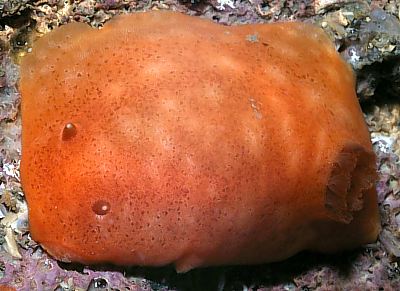
Rostanga aureamala
Garovoy, Valdés & Gosliner, 2001
Order: NUDIBRANCHIA
Suborder: DORIDINA
Superfamily: EUDORIDOIDEA
Family: Dorididae
DISTRIBUTION
Known only from Algoa Bay, South Africa.
PHOTO
Specimen from Algoa Bay, South Africa. PHOTO: T.M. Gosliner
The living animal is bright orange in colour, with several paler patches and numerous reddish spots. The perfoliate rhinophores are darker then the rest of the body, with opaque white protruding knobs. Each rhinophore has 14 horizontal, transverse lamellae. The gill is orange and consists of 10 bipinnate branchial leaves. The notum is covered with numerous, tall and wide caryophyllidia. Each caryophyllium consists of a central, spherical ciliated tubercle and six to seven tall spicules projecting around the margin of the tubercle. The anal papilla is located within the gill plume of branchial leaves. The foot is wider then the mantle margin. The anterior border of the foot is bilabiate and notched. The oral tentacles are well formed, and appear conical in shape. Preserved specimens to 40 mm in length.
Rostanga aureamala is clearly distinguishable from other members of the genus by its radular characters. In addition its colour separates it from the generally red species, R. elandsia.
Radular formula (preserved 20 mm spm) 61 x 86.1.86. See radula details. This species is known as Rostanga sp. 3 in Gosliner (1987)
- Garovoy, J.B., Valdés, A., & Gosliner, T.M. (2001) Phylogeny of the genus Rostanga (Nudibranchia), with descriptions of three new species from South Africa. Journal of Molluscan Studies 67: 131-144.
- Gosliner, T. M. (1987) Nudibranchs of Southern Africa, a guide to the Opisthobranchs of southern Africa. Monterey, Sea Challengers. 136 pp.
Rudman, W.B., 2002 (February 15) Rostanga aureamala Garovoy, Valdés & Gosliner, 2001. [In] Sea Slug Forum. Australian Museum, Sydney. Available from http://www.seaslugforum.net/factsheet/rostaure
